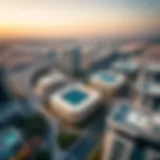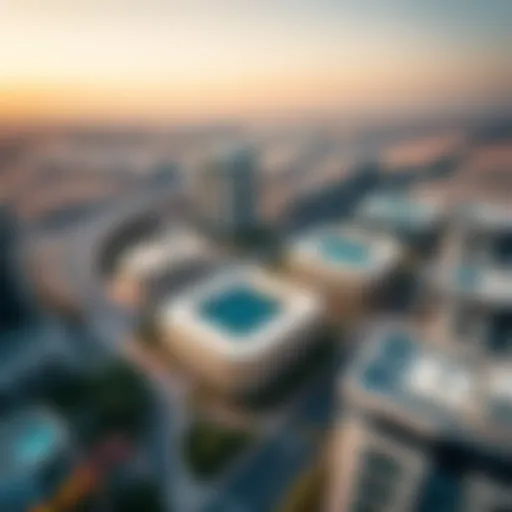Analyzing Architectural Partitions in Al Safa Tower
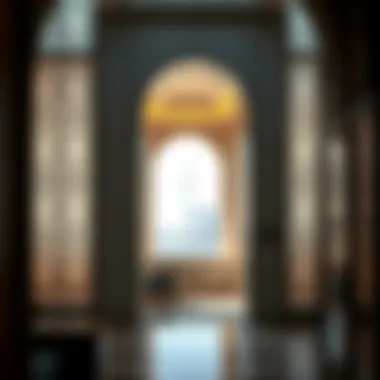

Intro
Understanding the architectural landscape of modern constructions in Dubai, particularly in landmark edifices like Al Safa Tower, reveals much about the city's evolving identity. Not just a place of shelter, the tower serves as a canvas where design intricacies meet practical needs. At its heart, the partition structures within Al Safa Tower encapsulate both functionality and artistry, fundamentally influencing a wide range of experiences for its occupants. By examining these partitions, one uncovers insights into the broader implications on liveability and real estate dynamics within the region.
Given the rapid development of Dubai, this discussion is both timely and significant for a diverse audience, including investors, homeowners, real estate agents, and analysts. The aim is to dissect the design philosophy behind these partitions, their material selections, and ultimately, how they shape the spatial dynamics of the tower. More than just structural necessities, these partitions significantly impact occupants’ daily experiences and even the workings of the real estate market in the bustling heart of Dubai.
As we peel back the layers, we shall delve into market trends, investment opportunities, and how the intricacies of partition structures play a pivotal role in defining the overall ethos of this architectural marvel.
Preface to Al Safa Tower
Al Safa Tower stands as a testament to modern architecture and urban living, shaping the skyline of Dubai. This section serves a crucial role in our analysis of partition structures, as it encapsulates the essence of why Al Safa Tower matters—not just as a piece of real estate but as a living organism thriving in a bustling metropolitan environment.
Understanding the Al Safa Tower lays the groundwork for appreciating the intricate design and functional benefits of its partitioning system. The way its partitions are crafted and positioned influences how spaces communicate with one another and how they serve the needs of the occupants.
Overview of Al Safa Tower
Al Safa Tower, located in the heart of Dubai, is more than just a physical structure; it's a multi-functional hub that houses luxury residences, commercial offices, and leisure areas. Completed in 2012, the tower rises majestically, offering stunning views that attract both residents and investors alike. With its sleek, modern aesthetic, it reflects the dynamic nature of Dubai’s urban sprawl.
From a bird’s-eye view, the tower resembles a finely crafted gem glittering amidst the desert gold. It stands approximately 50 stories tall, housing amenities that cater to diverse lifestyle needs—from gyms and swimming pools to landscaped gardens, all enveloped in a climate-controlled environment.
This remarkable structure is a beacon for homebuyers looking for a balance between opulence and comfort, marking Al Safa Tower as a key player in the competitive real estate market.
Architectural Significance
The architectural significance of Al Safa Tower cannot be overstated. Designed by a visionary team, the building integrates innovative partitioning systems that enhance spatial dynamics. The design emphasizes not only aesthetics but also functionality, ensuring that every corner serves a purpose without clutter.
- Use of Space: The layouts prioritize openness while strategically utilizing partitions for both privacy and collaboration, making it a prime example of versatile living.
- Incorporation of Technology: Cutting-edge technologies are embedded in the very fabric of the structure, offering energy-efficient solutions and ensuring sustainability.
- Materials Choice: Thoughtful selection of materials, including glass and steel, contributes to the tower's striking façade while maintaining the structural integrity necessary for high-rise buildings.
Understanding Partitions
When we talk about Al Safa Tower, it's essential to grasp the various dimensions of partitions and how they shape the experience within this architectural masterpiece. Partitions play a pivotal role in dividing a space, influencing both how the building functions and how inhabitants interact with it. They aren't just walls; they’re the unsung heroes of design that significantly impact everything from aesthetics to acoustics. Their importance extends into the realm of real estate, especially in a bustling market like Dubai, where maximizing space efficiently while ensuring comfort is crucial.
Definition of Partitions in Architecture
Partitions, in an architectural context, refer to internal walls or dividers that separate different areas of a building. Unlike exterior walls, which provide shelter and structural integrity, partitions focus on defining spaces within a structure. They can be permanent or temporary, depending on the needs of the environment. Their utility goes beyond mere division; they help in managing light, sound, and movement, thereby enhancing the daily experiences of the occupants.
Types of Partitions
Within Al Safa Tower, a variety of partitions can be observed, each serving distinct functions and contributing to the overall harmony of the building. Below are some prevalent types employed in this architectural setting:
Fixed vs. Movable Partitions
Fixed partitions are the stalwarts of any architectural design—they’re entrenched in place and serve as steadfast boundaries. Their primary advantage lies in their permanence, which makes them ideal for spaces that require definitive, unchanging divisions, such as conference rooms in Al Safa Tower. Conversely, movable partitions offer flexibility; they can be altered or relocated as needed. This adaptability makes them suited for multipurpose areas, allowing for swift changes in the configuration of spaces.
In the context of Al Safa Tower, combining both fixed and movable partitions can result in a dynamic environment where spaces can be redefined on-the-fly to accommodate a variety of functions—be it a bustling office during the day or a tranquil meeting space at night.
Soundproof Partitions
In a lively city environment, like Dubai, sound levels can become an issue, which is where soundproof partitions come into play. These partitions are engineered to control noise, allowing for a serene atmosphere in otherwise busy surroundings. Key to their functionality is the material composition; dense materials like gypsum or specialized acoustic panels are often used. In the setting of Al Safa Tower, soundproof partitions are particularly beneficial in areas meant for focus—like offices or conference rooms—ensuring that distractions from outside do not seep in, thus promoting productivity and privacy.
Glass Partitions


Glass partitions introduce a modern flair, combining transparency with division. They create the illusion of more space while still allowing for clear boundaries. The use of glass can enhance natural light penetration and maintain an open feel, which is vital in high-rise environments like Al Safa Tower. The major benefit here is the aesthetic appeal, as well as the perception of spaciousness they create. However, privacy can become a concern, which makes it crucial to balance their use with other partition types that offer better acoustic privacy when needed.
Incorporating glass as a partition material aligns perfectly with the contemporary design ethos of Al Safa Tower, where light and space are celebrated.
As we go forward in the article, understanding these partition types allows us to appreciate their significance in creating functional and appealing spaces within Al Safa Tower. Their roles are not merely practical; they also enrich the architectural narrative of the building.
Design Aspects of Partitions in Al Safa Tower
When it comes to partitioning within the Al Safa Tower, understanding the design aspects is paramount. The partitions are not simply walls; they play a crucial role in defining the aesthetics and functionality of the spaces within the tower. Various factors contribute to the selection and implementation of partitions, including materials, color schemes, and textures. These elements together enhance the identity and operational efficiency of the tower.
Materials Used
Wooden Partitions
Wooden partitions are often valued for their warmth and organic feel, bringing a touch of nature into modern architecture. The primary characteristic of wooden partitions is their versatility; they can be crafted in numerous styles, ranging from rustic to sleek and contemporary. This adaptability makes them a popular choice within Al Safa Tower, offering both functionality and aesthetic appeal.
One unique feature of wooden partitions is the ease with which they can be manipulated in design. They can be engineered to include sliding doors or movable panels, allowing for dynamic use of space. However, the disadvantages include susceptibility to moisture and fire, which may require careful treatment or design considerations. Overall, wooden partitions add charm and a sense of comfort to interiors while maintaining the balance between modernity and warmth.
Metal Framework
Metal frameworks stand out for their robustness and durability. One of the key characteristics of metal partitions is their structural integrity, which allows for tall and expansive designs without compromising safety or stability. This is especially significant in a high-rise building like Al Safa Tower, where space can be at a premium, yet open areas are desired.
The unique feature of metal frameworks is their ability to support large panels of glass or other materials, creating a lightweight yet strong partition. Additionally, they can easily incorporate other design elements, such as integrated lighting. Nevertheless, one must consider the potential drawbacks, such as higher initial costs and the need for careful design to avoid an overly industrial appearance. This balance defines the architecture and atmosphere of spaces created with metal partitions.
Glass Applications
Glass applications have become an increasingly popular choice in contemporary architecture for partitioning spaces. The primary characteristic of glass partitions is transparency, which can significantly enhance the perception of space and light. In Al Safa Tower, glass allows natural light to flow between rooms and areas, creating an uplifting environment while still providing a degree of separation.
A distinct feature of glass partitions is their ability to offer stunning views without physical obstruction. They can be used to create calming atmospheres that feel more open and inclusive. However, one disadvantage might be the lack of sound insulation compared to more solid materials. Additionally, maintenance can be a concern, as glass requires regular cleaning to maintain its clarity and aesthetic appeal. Yet, the elegance of glass partitions can elevate the design of any given area in the tower, showcasing an inviting landscape.
Color Schemes and Textures
The selection of color schemes and textures within the partition design plays a vital role in the overall ambiance of the Al Safa Tower. Colors can influence emotions, perceptions, and even productivity, and thus, careful thought goes into choosing the palette that complements the architectural identity of the tower.
Textures add a layer of complexity to the simple visual appeal of color, providing tactile elements that enhance the experience of the surroundings. From smooth glass and polished metal to grainy wood, the textures interact with light and shadow, creating a dynamic environment. Together, color schemes and textures create an inviting atmosphere that has a significant impact on occupant experience, promoting a positive interaction with space.
Overall, the design aspects of partitions in Al Safa Tower incorporate a rich blend of materials, colors, and textures that serve a greater purpose than mere separation of space. They resonate with the building's intended use while simultaneously elevating its architectural significance.
"Design, when done correctly, transforms places into experiences, creating an interplay between space and human interaction."
Functional Benefits of Partitioning
The role that partitions play in architecture cannot be overstated, particularly in structures like Al Safa Tower. These divisions of space do not merely serve aesthetic purposes; they are integral in enhancing functionality, which can significantly influence both the user experience and property value. Understanding the benefits of these architectural elements is crucial for those eyeing investments, be it homebuyers, real estate agents, or market analysts.
Maximizing Space Efficiency
When it comes to urban environments where every square meter counts, maximizing space efficiency is paramount. Partitions allow for the optimal utilization of available space, creating designated areas that can serve various purposes without the need for extensive construction. For example, a single large office can be transformed into multiple workstations or meeting rooms through the strategic placement of movable or adjustable partitions. This flexibility is prized in commercial settings, where the needs of a business might change over time.
With smart design choices, like the implementation of glass partitions, one can enhance the perception of space while maintaining privacy. Such designs can create a spacious feeling, preventing claustrophobia while also enabling natural light to flow through different sections. It’s about juggling aesthetics and utility.
Additionally, the choice of materials plays a significant role. Lightweight yet durable materials can help ensure that partitions do not weigh down the overall design of a space. In the case of Al Safa Tower, the combination of wood and glass showcases how one can achieve an open feel without sacrificing functionality. This careful balance can lead to smoother operations and productivity gains, notably in workplaces.
"Partitions are the unsung heroes of architectural design—balancing functionality with elegance."
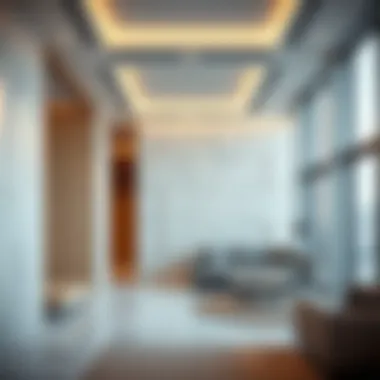

Improving Privacy
Privacy is another indispensable advantage that partitions provide. In bustling environments, the need for privacy becomes critical, whether in an office, a residential unit, or public spaces. Partitions afford the opportunity to create intimate sections without needing full walls. This is particularly beneficial in shared spaces, such as co-working offices found in Al Safa Tower, where multiple businesses coexist under one roof. Each business can maintain its quarter, fostering both professional interaction and confidentiality.
For example, soundproof partitions can be particularly effective in areas where concentration is vital. They help significantly reduce noise pollution, allowing individuals to focus on their tasks with minimal distractions. The selection of materials matters here too; solid partitions can absorb sound better than glass ones, but where visual connectivity is desired, a hybrid approach can work wonders.
In the residential aspect, for families living in Al Safa Tower, partitions can delineate bedrooms or personal spaces, fostering a sense of sanctuary from communal areas. This separation not only can improve comfort but also enhances the quality of life by preserving one’s personal space in a busy building. With a thoughtfully designed approach to privacy, residents can feel more at home while still being part of a larger community.
In summary, the functional benefits of partitioning in Al Safa Tower are multi-faceted. Whether for maximizing space efficiency or enhancing privacy, partitions are key architectural elements that contribute to a better living and working environment. Investors should recognize the value that these elements bring to property in the evolving landscape of Dubai’s real estate market.
Impact on Occupant Experience
The design and execution of partition structures in Al Safa Tower play a significant role in enhancing the overall experience of its occupants. This section focuses on the nuances involved in creating an environment that feels both spacious and private, capturing the essence of state-of-the-art architectural design. Partitions serve not just as physical divides, but as instrumental elements that influence how individuals interact with their surroundings. Here, we will discuss two prime facets of occupant experience: creating distinct areas and fostering acoustic comfort.
Creating Distinct Areas
Partitions within Al Safa Tower are masterfully crafted to delineate various functional zones while maintaining a sense of openness. The thoughtful arrangement of these partitions facilitates the effortless transition from one area to another, be it a collaborative workspace, private office, or lounge area. For instance, the use of glass partitions accentuates natural light, allowing spaces to feel more connected despite being separated. This practice underscores the idea that partitions are not merely barriers but enhancers of visual continuity.
Additionally, the specific configurations of these spaces cater to various activities, whether it is brainstorming sessions, client meetings, or quiet reflection. The adaptability of the designs allows businesses to modify the configuration as needed without extensive renovations, giving them flexibility. A well-thought-out spatial arrangement can lead to increased productivity and well-being amongst occupants, amplifying workplace morale.
Key components of creating distinct areas include:
- Visual separation: Partitions that allow for sightlines without complete obstruction.
- Multi-functional designs: Configurations that serve several purposes as needed, such as boardroom to lounge.
- Personalized zones: Spaces designed with specific functionality in mind, enhancing the user's daily experience.
By blending innovative design with functionality, these partitions not only establish boundaries but also enrich the spatial experience, making every corner of Al Safa Tower distinctly significant.
Acoustic Comfort
Acoustic comfort is a paramount consideration in the design of partitions within Al Safa Tower. The goal is to create environments that enable occupants to focus and communicate effectively without being hindered by outside noise or distractions. Here, specialized soundproof partitions come into play. These partitions are crafted from materials designed not just for aesthetics, but with an emphasis on sound attenuation as well.
Investors and commercial space users should be particularly aware of how important sound privacy can be in boosting productivity and ensuring comfort among employees. The use of soundproof materials minimizes the intrusion of disruptive sounds, making it easier for occupants to concentrate on their tasks.
For potential buyers or tenants, the acoustic quality of a workspace can be a deal-breaker. Spaces equipped with efficient acoustic solutions often command higher value in the competitive real estate market.
When examining the acoustic features of partitions, one might consider:
- Absorption capabilities: Materials that absorb sound rather than reflect it back into the space.
- Sealing technology: Ensuring that gaps in partitions do not allow sound to leak through.
- Strategic placement: Positioning partitions to create 'quiet zones' where concentration can thrive.
Economic Ramifications in Real Estate
Understanding the economic ramifications tied to partitioning in Al Safa Tower is essential for grasping the larger narrative of its influence on the real estate market in Dubai. Partitions not only serve functional purposes but also directly impact the financial considerations of designing and selling properties. The interplay between architecture, design, and value creation cannot be overstated, especially in a competitive landscape like Dubai’s property sector.
Value Addition Through Design
Partitions, particularly when they are well-designed, have a unique potential to elevate property value. When buyers and investors look at Al Safa Tower, the design of the partitions can either make or break their perception of space usage and aesthetic appeal. For instance:
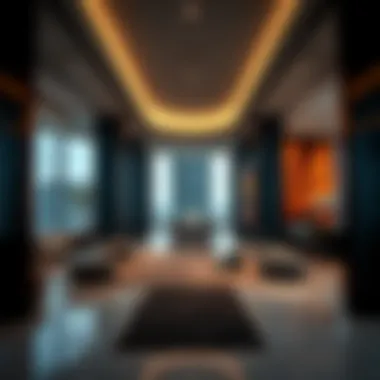

- Aesthetic Appeal: High-quality materials like glass or custom-designed wooden partitions enhance visual allure. Elegant space divisions create an upscale ambiance, making properties more desirable.
- Functional Layout: Smartly designed partitions optimize layout, maximizing useable space. This aspect resonates with buyers, as properties with open yet functional spatial arrangements often fetch higher prices.
- Flexibility: Movable partitions allow for multipurpose spaces. This flexibility is particularly appealing to businesses that wish to adapt their environments for different events or seasons.
In essence, how partitions are crafted can significantly bolster the value proposition of Al Safa Tower, influencing investor interest positively.
Market Appeal of Partitioned Spaces
In the realm of property marketing, the appeal of partitioned spaces within Al Safa Tower is clear. Today's real estate market leans heavily not just on location but also on how space is perceived and utilized. Here are some compelling aspects to consider:
- Increased Functionality: Buyers are interested in spaces that can adapt to various functions. Well-placed partitions create spaces that can serve as offices, lounges, or meeting rooms depending on needs, thus appealing to a diverse range of buyers.
- Enhanced Privacy: Buyers are increasingly valuing privacy within shared spaces. Partitions that provide soundproofing or visual barriers cater directly to this desire, enhancing the perceived value of the property.
- Desirability of Modern Design: With trends shifting towards contemporary aesthetics, the modern look of partitioned areas can significantly increase market appeal. Property seekers are swayed by clean lines, innovative designs, and sleek materials.
All these elements lend themselves to creating an attractive package that’s hard to resist for investors and buyers looking to make a purchase in a crowded market.
"In the fast-paced world of real estate, design choices are as important as location. A well-structured partition not only defines spaces but solidifies value."
Ultimately, the economic implications of partitions in Al Safa Tower mirror broader trends in architectural design and property value in Dubai, underscoring the importance of these elements in cultivating an appealing market presence.
Sustainability Considerations
Sustainability is more than just a buzzword; it's become a cornerstone in contemporary architecture and design. In the context of Al Safa Tower, partitions play a pivotal role in fostering sustainability practices that echo the broader objectives of environmental responsibility and efficient resource management. By integrating sustainable elements, the tower not only enhances its functionality but also contributes positively to the overall urban ecosystem.
With the growing awareness of climate change, eco-friendly design choices are gaining traction. Incorporating partitions that prioritize sustainability offers numerous benefits. The main focus areas include:
- Material Selection: The choice of materials used in partition construction significantly impacts both the environment and sustainability goals.
- Energy Consumption Reduction: Well-designed partitions can optimize energy use in living and working spaces.
- Waste Management: Sustainable practices in partition installation can lead to minimal waste generation.
"Sustainability in architecture is not just about being green; it’s about being smart and efficient in resource use."
Eco-Friendly Materials
When we talk about eco-friendly materials, we're not just discussing the 'green' label. It refers to materials that boast minimal environmental impact throughout their life cycle. In Al Safa Tower, various materials demonstrate this commitment to sustainability. Some notable types include:
- Reclaimed Wood: This material not only adds character but also reduces the need for new lumber, preserving forests.
- Recycled Steel: Known for its durability, recycled steel easily meets building codes while minimizing the environmental footprint associated with new steel production.
- Low-VOC Paints and Finishes: These products contribute to healthier indoor air quality and reduce toxic emissions, a benefit for both occupants and the environment.
By utilizing these materials in the partition designs within Al Safa Tower, the architects ensure a sustainable approach that aligns with global environmental standards and enhances the aesthetic appeal of the space.
Energy Efficiency in Design
The efficiency of a building is significantly influenced by the strategic design of its partitions. In Al Safa Tower, energy-efficient designs ensure that spaces are not only comfortable but also cost-effective. Here are some aspects to consider:
- Thermal Insulation: Well-placed partitions can act as barriers that help in regulating indoor temperatures, reducing the dependency on heating and cooling systems.
- Natural Light Utilization: Glass partitions, when used wisely, can maximize natural light intake, thereby decreasing reliance on artificial lighting.
- Smart Technology Integration: Modern partitions may contain technology that adjusts transparency or reflectivity according to the time of day, optimizing energy use throughout.
In summary, designing with energy efficiency at the forefront contributes not just to lower operating costs, but also to a more sustainable future. By choosing things like eco-friendly materials and efficient designs, Al Safa Tower stands as a benchmark for sustainability in modern architecture.
Finale
The exploration of partition structures in Al Safa Tower elucidates their fundamental role in shaping both the functionality and aesthetics of this iconic building. Partitions are more than mere dividers; they are critical components in optimizing spatial design and enhancing occupant experiences. This article has highlighted key elements such as materials used, types of partitions, and their soundproofing capabilities, all contributing to the synergy of design and utility.
Summary of Key Insights
In summary, the significance of partitions in Al Safa Tower can be encapsulated into several distinct insights:
- Design Versatility: Partitions come in various forms—ranging from fixed to movable—which allows for customized configurations to suit different areas of the tower.
- Material Choice: The use of eco-friendly materials not only aligns with sustainability goals but also enhances the building’s aesthetic appeal. For instance, a blend of glass and wood not only preserves an open feel but provides warmth and privacy.
- Acoustic Optimization: With soundproof partitions thoughtfully integrated, the comfort of residents is paramount, ensuring that the urban hustle remains at bay.
- Market Value: Effective partitioning directly correlates with the real estate market value, as adaptable spaces appeal to a broader range of prospective occupants, boosting occupancy rates.
Future Trends in Partitioning
Looking ahead, several trends are worth noting in the realm of partitioning:
- Smart Partitions: As technology continues to progress, the introduction of smart partitions equipped with integrated lighting or sound control systems could revolutionize how spaces are utilized.
- Sustainability Focus: The ongoing shift towards green architecture will likely see a rise in the demand for partitions made of recycled or sustainable materials, reflecting a wider commitment to eco-friendly building practices.
- Flexible Spaces: The trend for multi-functional spaces will drive innovations in movable partition design, allowing environments to adapt to various needs throughout the day, from meetings to social gatherings.
- Health and Well-Being: Emphasis on mental well-being may result in an increase in biophilic design in partitions, incorporating natural elements to improve occupant comfort and overall satisfaction.


